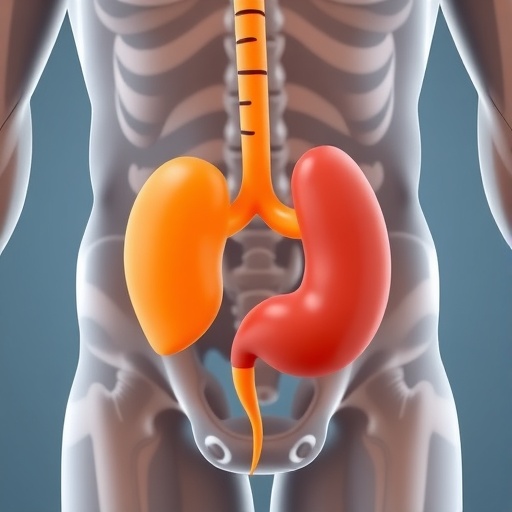Urolithiasis, commonly known as kidney stones, represents one of the most pervasive urological conditions worldwide, characterized by stone formation within the urinary tract. These calculi can precipitate severe clinical symptoms including intense pain, urinary tract infections, and, in worst-case scenarios, renal failure. The burden of urolithiasis extends far beyond individual suffering, posing a substantial economic strain on healthcare systems globally. Despite its significance, comprehensive and systematic analyses of its epidemiological trends and socio-demographic impacts remain sparse—a critical gap in knowledge for directing global health initiatives.
Recent groundbreaking research conducted by a collaborative team from Sun Yat-Sen University in Guangdong and Peking University in Beijing offers unprecedented insights into the global burden of urolithiasis. Leveraging data from the extensive Global Burden of Diseases (GBD), Injuries, and Risk Factors Study 2021, this investigation provides a rigorous epidemiological evaluation spanning three decades. The study meticulously assesses incidence rates, disability-adjusted life years (DALYs), and mortality statistics across 204 countries and territories, tracing the trajectory of this disease from 1990 to 2021.
The analytical framework focuses on key epidemiological metrics including the age-standardized incidence rate (ASIR), age-standardized disability-adjusted life year rate (ASDR), and age-standardized mortality rate (ASMR). Notably, these parameters are stratified by sex, age, and socioeconomic indices, revealing stark disparities in disease patterns. Male patients consistently exhibit significantly higher ASIR, ASDR, and ASMR values compared to females, highlighting a pronounced gender differential in the epidemiology of urolithiasis. Particularly, regions such as Southeast Asia demonstrate an elevated male-to-female incidence rate ratio, underscoring regional variations potentially driven by environmental, genetic, or socio-cultural factors.
Intriguingly, the study reveals an inverse relationship between socioeconomic status and gender disparities in disease outcomes. Countries with higher sociodemographic indices display reduced male-to-female ratios in mortality and disability rates, suggesting that advanced healthcare infrastructures and equitable resource allocation are pivotal in mitigating these disparities. This relationship is quantitatively supported by correlation analyses demonstrating a modest, yet statistically significant, positive association between sociodemographic index and male-to-female incidence rate ratios at both regional (R = 0.23, P < 0.001) and national levels (R = 0.33, P < 0.001).
Globally, the overall age-standardized rates of incidence, disability, and mortality have exhibited a general decline over the past 30 years. However, disaggregated data reveal nuanced temporal trends within specific demographics. Particularly concerning is the less pronounced decline in female ASIR over the last decade, coupled with an increase in ASDR and ASMR among women. This pattern signals an emerging vulnerability within female populations, potentially attributable to changes in lifestyle factors, healthcare access, or biological susceptibility requiring urgent scientific and policy attention.
Geographically, Eastern Europe emerges as the region with the highest ASIR, ASDR, and ASMR for urolithiasis as of 2021. Contrastingly, China demonstrates substantially lower incidence and mortality rates relative to the global average. The Chinese healthcare system’s notable progress is attributed to multifaceted improvements including dietary habit modifications, widespread health education, technological advancements in diagnosis and treatment, and robust public health policies. This multipronged approach integrates community-level awareness with systemic insurance mechanisms, facilitating early detection and management of urolithiasis and thereby reducing its population-level burden.
The study’s methodological rigor is reflected in the comprehensive statistical data analysis derived from GBD 2021, demonstrating the value of large-scale epidemiological studies in understanding complex health issues. By quantifying health loss metrics such as DALYs alongside incidence and mortality, the researchers provide a holistic portrait of urolithiasis’ impact, capturing both clinical severity and the broader implications for population health and healthcare delivery.
From a public health perspective, the gender-based disparities observed underscore the necessity of tailored interventions that consider biological and socio-environmental determinants. The persistence of higher disease burden in males globally, with recent shifts indicating increasing female vulnerability, demands adaptive strategies in clinical management, preventive education, and resource allocation. These findings challenge healthcare providers and policymakers to reassess existing paradigms and prioritize equity-focused approaches.
Furthermore, the socioeconomic gradient highlighted in this research accentuates the role of health equity in disease mitigation. Lower socioeconomic regions bear disproportionately higher burdens, reflecting systemic challenges including limited healthcare access, suboptimal nutrition, and inadequate disease awareness. Addressing these determinants is paramount in curbing the increasing incidence and adverse outcomes of urolithiasis worldwide.
This landmark study not only illuminates current epidemiological trends but also sets the stage for future research directions. Investigations into underlying etiological mechanisms, socio-behavioral drivers, and intervention efficacy across diverse populations are essential to inform evidence-based policies. Collaborative global efforts inspired by such data-driven insights can ultimately dismantle the entrenched disparities in urolithiasis burden.
In conclusion, the comprehensive analysis of urolithiasis burden over the past three decades reveals complex epidemiological patterns marked by global increases in case numbers and mortality, pronounced gender and regional disparities, and significant influence of socioeconomic factors. Public health policies inspired by these findings could steer the global community towards more equitable healthcare delivery, optimized preventive strategies, and enhanced clinical outcomes for individuals afflicted by this debilitating condition.
The global rise in urolithiasis and its associated health burdens serve as a clarion call to intensify research, resource investment, and policy innovation. By embracing multidisciplinary approaches that integrate epidemiological data with clinical insights and health systems strengthening, the global health community can aspire to reduce the impact of urolithiasis and improve quality of life for millions worldwide.
Subject of Research: People
Article Title: Trends and sex disparities in the burden of urolithiasis in 204 countries and territories, 1990–2021
News Publication Date: 17-Jul-2025
Web References:
https://journals.lww.com/cmj/fulltext/9900/trends_and_sex_disparities_in_the_burden_of.1627.aspx
References:
DOI: 10.1097/CM9.0000000000003622
Image Credits: Chinese Medical Journal
Keywords:
Nephropathies, Urology, Public health, Health and medicine, Epidemiology, Mortality rates, Health care policy, Preventive medicine, Nutrition, Gender




